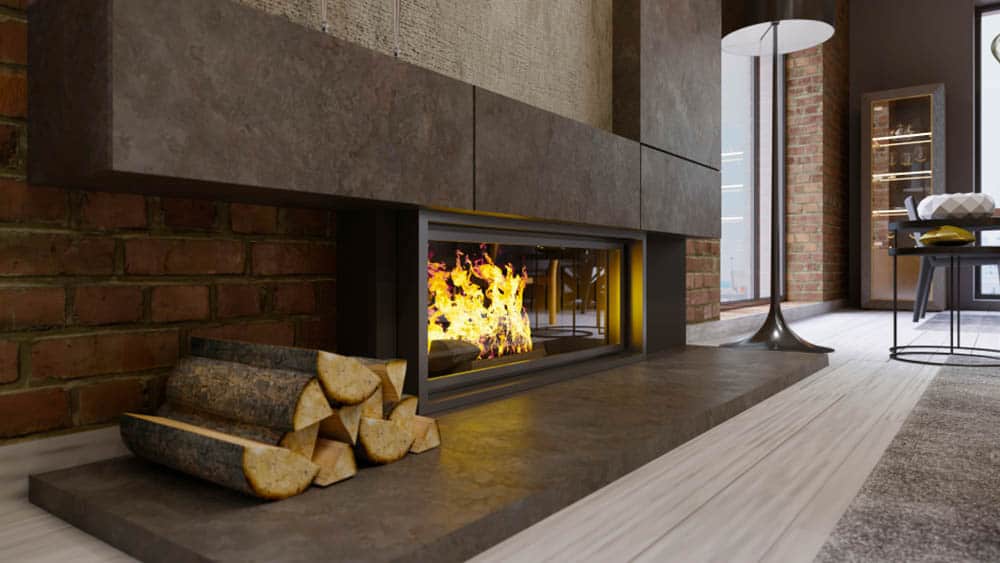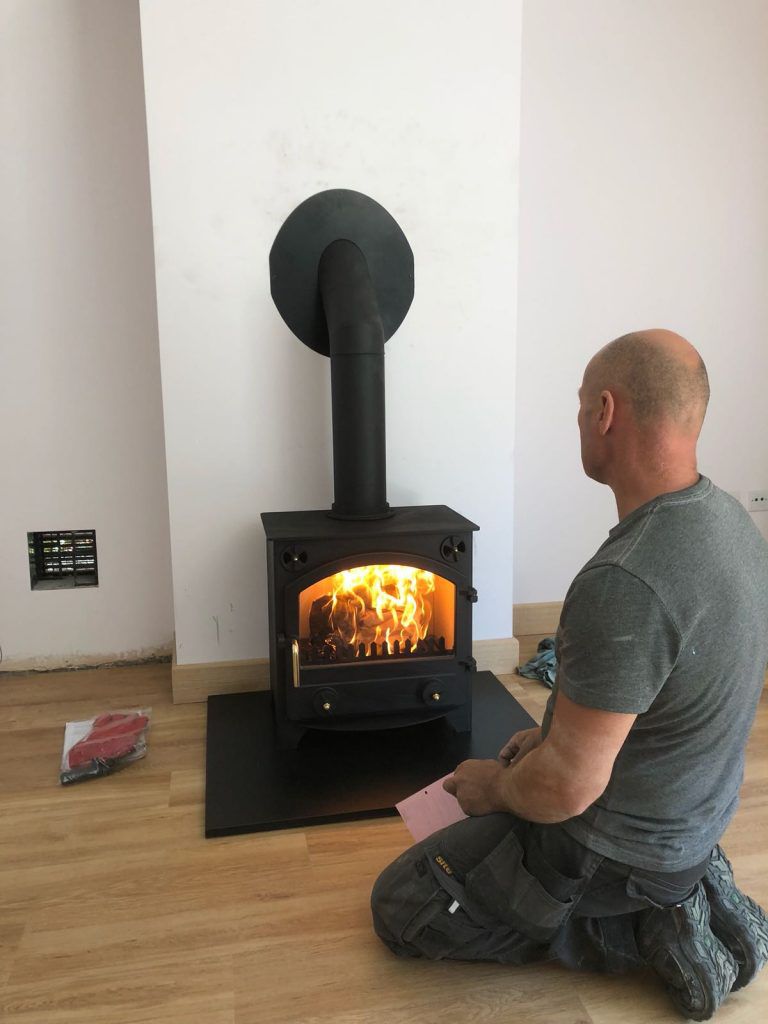No, you don’t need a traditional chimney for a gas fireplace, but you do require a ventilation system such as a Class A Flue or B-vent for proper operation. While a brick chimney can work, it’s not the only option.
Direct vent technology allows gas fireplaces to be vented directly through the wall, expelling combustion byproducts safely outdoors without the need for a full chimney construction. These modern systems provide efficient heating and are a cost-effective solution for adding a fireplace to your home without the hassle of a traditional chimney.
Whether you prefer the ambiance of a gas fireplace without the need for a chimney or are exploring venting options, there are flexible solutions available to suit your needs and space.

Credit: www.boilercentral.com
Types Of Gas Fireplaces
When it comes to gas fireplaces, there are two main types to consider: Vented Gas Fireplaces and Ventless Gas Fireplaces. Each type offers unique features and benefits to suit different needs and preferences.
Vented Gas Fireplaces
- Vented gas fireplaces require a chimney or venting system to expel combustion byproducts outside.
- They offer a realistic flame appearance but may not be as energy-efficient as ventless options.
- These fireplaces use air from inside your home for combustion and expel the byproducts through the venting system.
Ventless Gas Fireplaces
- Ventless gas fireplaces do not require a chimney or external venting.
- They are more energy-efficient as they recirculate indoor air for combustion and release heat directly into the room.
- These fireplaces are easy to install and can be placed in various locations within a home.
If you’re considering a gas fireplace, it’s essential to understand the differences between vented and ventless options to choose the best fit for your space and heating needs. Remember to consult with a professional before making your final decision.

Credit: cielowigle.com
Ventilation Options
When it comes to gas fireplaces, proper ventilation is crucial for safety and efficiency. Understanding the different ventilation options available can help you determine the best choice for your home.
Direct Vent Technology
Direct vent technology allows gas fireplaces to be vented directly through a wall to the outdoors using a dual-chambered single pipe. This system draws air from outside for the fire and expels combustion byproducts, ensuring clean indoor air quality.
Class A Flue Or B-vent
Class A flue is a top-quality flue option that offers durability and safety. It is designed to last longer and provides a secure venting solution for gas fireplaces. On the other hand, B-vent is another viable option for ventilation in gas fireplaces, offering a cost-effective and efficient venting solution.
Consider your home’s layout and your specific needs when choosing between Class A Flue or B-Vent for your gas fireplace ventilation requirements.
Installing A Gas Fireplace
When planning to install a gas fireplace, it’s crucial to understand the various venting options and technologies available. Utilizing the right venting system is vital for ensuring the safety, efficiency, and performance of your gas fireplace. In this section, we’ll explore the different venting options, specifically focusing on direct vent technology and venting without a chimney.
Utilizing Direct Vent Technology
Direct vent technology is a popular choice for gas fireplaces as it offers greater flexibility in installation and improved energy efficiency. This system uses a coaxial vent pipe, which consists of an inner pipe for exhaust and an outer pipe for fresh air intake. The sealed design prevents any combustion byproducts from entering the living space, ensuring superior indoor air quality. Additionally, direct vent gas fireplaces can be installed in various locations within a home, including against an exterior wall, making them a versatile option for homeowners.
Venting Without A Chimney
One of the significant advantages of gas fireplaces is the ability to vent without a traditional chimney. Through direct vent technology, gas fireplaces can be vented directly through an exterior wall. This method eliminates the need for costly chimney construction and provides homeowners with greater flexibility in choosing the fireplace’s location within their home. Direct venting not only simplifies the installation process but also ensures that the combustion byproducts are safely expelled outside the living space, maintaining a clean and healthy indoor environment.
Considerations
When considering a gas fireplace, you don’t necessarily need a traditional chimney. Instead, a ventilation system like Class A Flue or B-vent is needed to ensure proper airflow and safety. Direct vent technology allows for venting directly through the wall, providing an efficient and convenient solution without expensive chimney construction.
Efficiency
When considering whether you need a chimney for a gas fireplace, one of the key factors to take into account is the efficiency of the fireplace. Gas fireplaces are known for their high efficiency, offering a convenient and cost-effective way to heat your home. With a properly installed and vented gas fireplace, you can enjoy efficient heating without the need for a traditional chimney.
Gas fireplaces are designed to burn clean and produce minimal emissions, making them an eco-friendly heating option. The flames in a gas fireplace can be easily regulated, allowing you to control the amount of heat produced. This means that you can enjoy a cozy atmosphere without wasting energy.
Furthermore, gas fireplaces come equipped with various features to enhance efficiency. For example, many models have built-in thermostats that allow you to set a desired temperature. Once the desired temperature is reached, the fireplace will automatically adjust the flame height to maintain consistent heat levels. This not only ensures comfort but also helps reduce energy consumption, resulting in significant cost savings over time.
Safety
Safety is another crucial consideration when it comes to gas fireplaces. While traditional wood-burning fireplaces pose inherent safety risks, gas fireplaces offer a safer alternative. They eliminate the need to handle and store firewood, reducing the risk of accidents and potential hazards.
However, it is important to ensure proper installation and ventilation for your gas fireplace to maintain safety. While a traditional chimney may not be necessary, a ventilation system is required to remove the byproducts of combustion. The two common types of venting options for gas fireplaces are Class A Flue and B-vent.
Class A Flue is the highest quality flue available, offering a longer lifespan and enhanced safety. It is designed to effectively remove gases produced during combustion and prevent any harmful emissions from entering your home. B-vent, on the other hand, is a less expensive option that relies on natural draft to vent the fireplace. Both options provide a secure and efficient means of venting your gas fireplace.
Comparing Flueless And Traditional Gas Fireplaces
When considering a gas fireplace, you may also come across the terms “flueless” and “traditional” fireplaces. Understanding the differences between these two options can help you make an informed decision.
| Flueless Gas Fireplaces | Traditional Gas Fireplaces |
|---|---|
| Do not require a chimney or external venting | Require a chimney or ventilation system for combustion byproduct removal |
| Can be installed in various locations within your home | Must be installed in proximity to a chimney or vent |
| Offer flexibility in terms of placement and design | May require modifications to existing architecture |
| Provide efficient heating with controlled emissions | Ensure proper ventilation and emission control |
Ultimately, the choice between a flueless and traditional gas fireplace depends on your specific requirements and the structure of your home. Flueless fireplaces offer more flexibility in terms of installation and design possibilities, while traditional fireplaces require a chimney or vent for proper ventilation.
Regardless of the option you choose, it is essential to ensure compliance with local building codes and regulations for the safe installation and use of gas fireplaces.

Credit: www.wakefordfireplaces.com
Frequently Asked Questions Of Do I Need A Chimney For A Gas Fireplace
Can You Add A Gas Fireplace Without A Chimney?
You don’t need a traditional chimney for a gas fireplace. Instead, you’ll require a ventilation system like Class A Flue or B-vent for proper installation. Additionally, direct vent technology enables the venting of gas fireplaces directly through the wall without expensive chimney construction.
How Do You Vent A Gas Fireplace Without A Chimney?
Vent a gas fireplace without a chimney by using direct vent technology through a dual-chambered single pipe. No costly chimney construction needed.
Does A Gas Fireplace Need A Working Chimney?
A gas fireplace doesn’t need a traditional chimney, but it requires a venting system like Class A Flue or B-vent for proper ventilation.
Do You Need A Chimney For A Gas Fire?
No, traditional brick chimneys are not needed for a gas fireplace. A ventilation system, like Class A Flue or B-vent, suffices.
Can I Install A Gas Fireplace Without A Chimney?
No, you don’t necessarily need a traditional brick chimney. A ventilation system like Class A Flue or B-vent can be installed instead.
Conclusion
While a traditional chimney may work for a gas fireplace, it’s not always necessary. Instead, a ventilation system such as a Class A Flue or B-vent can be used. Direct vent technology allows for venting directly through the wall, eliminating the need for expensive chimney construction.
This makes adding a gas fireplace to your home a feasible option without the requirement of a traditional chimney.